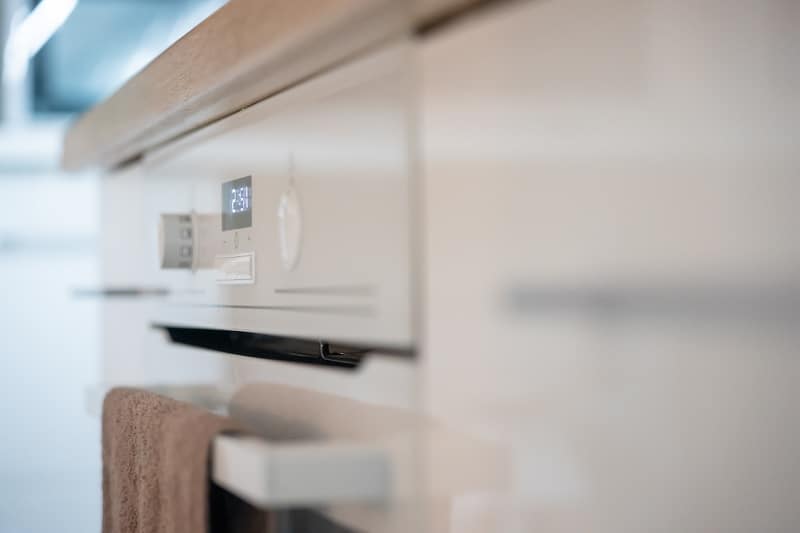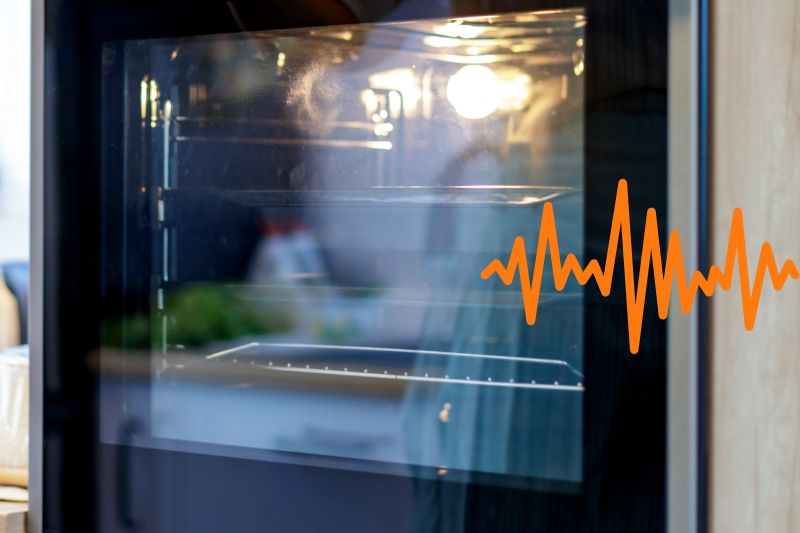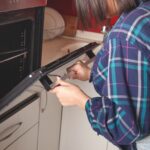It’s normal for ovens to make a little noise while running. However, while some sounds aren’t normal.
If you hear grinding, rattling, screeching, scraping, clicking, or buzzing, it typically means something has gone faulty—or at least is starting to go faulty.
Rattling noises are among the most common abnormal sounds that your oven can make. When you hear your electric oven making a rattling noise, it can be disconcerting and worrying.
But if your oven is making strange noises, don’t worry. Here, we delve into some common culprits behind the rattling sounds in your electric oven and share actionable solutions you can use to fix the issue.
Why Is My Electric Oven Making a Loud Rattling Noise?
If you hear your electric oven making a rattling noise, it could be caused by faults in various components.
You will need to investigate your appliance, and when you do, keep these common noise-creating components in mind.
Reason 1: Faulty impeller fan

Out of all the types of electric ovens, convection ovens are most likely to make a rattling sound.
These ovens feature an additional impeller fan that circulates hot air for even heating. This leads to more even heating, resulting in perfectly cooked dishes.
However, this extra fan introduces potential problems over time. Several issues can arise that result in strange sounds coming from your oven.
The fan blade may warp, leading to banging sounds; the spindle may squeak or squeal due to dirt or lack of lubrication, or the fan blade itself might emit squeaks as it rotates.
If you can hear a rattling noise, the most likely situation is that the impeller fan has rusted.
As the fan inside your oven starts to rust, the surface becomes uneven and unable to spin smoothly. When rotating at high speeds, the fan may become imbalanced and begin to rattle.
Hint: This is the most likely cause of a rattling noise if you have a convection oven.
Reason 2: Malfunctioning cooling fan
You might encounter similar rattling noises even in ovens without a convection fan. These sounds most commonly originate from the cooling fan. This fan typically runs automatically after oven use to cool down the appliance rapidly.
It should be easy to tell if this is causing the rattling noise in your electric oven by considering when you hear it.
If the rattling becomes apparent as you switch off the oven, it’s likely due to cooler fan issues.
Again, this problem might stem from a malfunction or merely a buildup of grease, food particles, and debris around the blades.
Hint: This is the most likely cause if the rattling sound starts after turning the oven off.
Reason 3: Loose oven panels

Rattling can also result from loose oven panels. Ovens naturally produce small vibrations due to gas or electricity use, which can cause loose panels or screws to vibrate and create noise.
Rattling sounds perfectly describe the noise as the screws shake in their place.
This is more likely to be the cause of the strange oven sounds if you’ve recently performed a repair.
If you’ve removed a body panel to make repairs, you may not have secured it tightly when reassembling.
Double-check the tightness of screws and panels in the area you worked on. If you haven’t made any recent repairs, try tightening all screws to see if it helps.
Hint: This is the most likely cause if you have recently performed a repair on your oven.
Reason 4: Loose door lock
Pay close attention to where the ratting sounds are coming from. If they’re emanating from the door area of your oven during its operation, the door lock should be your primary suspect.
When not locked properly, the tiny vibrations from the electric oven cause the door to wobble and rattle.
The door lock mechanism ensures the oven door remains closed during high-heat operations like cleaning protocols in self-cleaning ovens or as a safety measure to prevent injuries and access by children.
Over time, this mechanism can come loose and lead to rattling. As the lock becomes looser and looser, you may also find it challenging to close the oven door properly.
Hint: This is the most likely cause for rattling if the noise comes from the oven door.
How Do I Stop My Oven from Rattling?
Now that we’ve uncovered the common sources of rattling noises in your electric oven, it’s time to address these issues and restore a calm cooking environment.
The door of your oven can be accessed easily. However, bear in mind that you will need to be able to access the back of your oven to reach the fans and oven panels.
If you have a built-in double oven or built-in single oven, carefully take it out of its housing before continuing with the steps below.
Important: For safety reasons, you should also turn off your oven and unplug it from the mains before inspecting any of the components and attempting the following solutions.
Issue 1: Impeller fan maintenance
One of the primary culprits of noise is a deteriorating impeller fan. Typically located at the back of the oven, this fan promotes even heating by circulating hot air.
In most cases, the fan isn’t damaged, it simply needs a good cleaning or lubrication. During its operation, the fan circulates not only hot air but also tiny food particles and grease, which can accumulate and cause noise.
Before rushing to buy replacement fan components, start by inspecting and cleaning the existing parts by following these steps:
- Carefully remove any fan covers, exercising caution as some components may be hot.
- Inspect the impeller fan for rust, debris, warped blades, or other causes of imbalances.
- If necessary, clean the blades or reattach them if they’ve become loose.
- For warped or extremely damaged fans, buy a new fan or blade and replace the faulty one.
- Test the oven to verify that the noise has been resolved.
Issue 2: Cooling fan
The cooling fan plays a vital role in maintaining the temperature in the oven and preventing overheating.
If it’s emitting noise, it’s time to address the issue before it becomes completely faulty and cannot cool your oven after use. Here’s how:
- Locate the cooling fan on the back panel of your electric oven.
- Remove the two electrical connections going to the fan.
- Unscrew the cooling fan from the oven with a screwdriver.
- Remove accumulated dust and debris that may be causing the noise.
- Fit the cooling fan back into the oven and recommend the electrics.
Issue 3: Loose oven panels
Loose oven panels can lead to rattling sounds as the screws vibrate during cooking.
If you’ve recently made a repair, ensuring that all parts are securely fastened is essential. To do this, follow these steps:
- Listen closely to the rattling sound to see which part of the oven it comes from.
- Double-check the tightness of screws in the area where the rattling is most pronounced.
- If any screws are missing, replace them and screw them in tightly.

Issue 4: Door lock replacement
When the rattling originates from the oven door area, the door lock mechanism may be the culprit.
Unfortunately, tightening the door lock like a loose screw is not an option. The most effective solution is to replace the entire lock mechanism with a new one, which should eliminate the rattling noise.
Here are the steps you need to follow when replacing your electric oven door lock:
- Open the oven door and locate the lock (usually in the door frame or door itself).
- Unscrew the fasteners holding the lock in place according to the oven instruction manual.
- Disconnect any wires connected to the old lock, remembering how they were attached.
- Insert the new door lock, reattach the wires, and screw it securely in place.
- If you had to remove the door to access the lock, reassemble the oven door.
- Test the oven lock to ensure it engages and disengages as it should.
- Put your electric oven on to see if the rattling noise has stopped. bu
Remember, the steps provided are general guidelines, and the specific process can vary based on the make and model of your electric oven.
Consult the user manual or seek guidance from the manufacturer for instructions tailored to your appliance.
If you’re unsure about any aspect of the repair, it’s wise to consult a professional technician to ensure the job is done safely and effectively.

Hannah is a freelance content writer and self-proclaimed foodie. When Hannah isn’t sitting tapping at her laptop, you’ll probably find her in the kitchen. As an ex-chalet host, she’s used to cooking four-course meals for 10+ people and loves feeding friends and family whenever possible.







